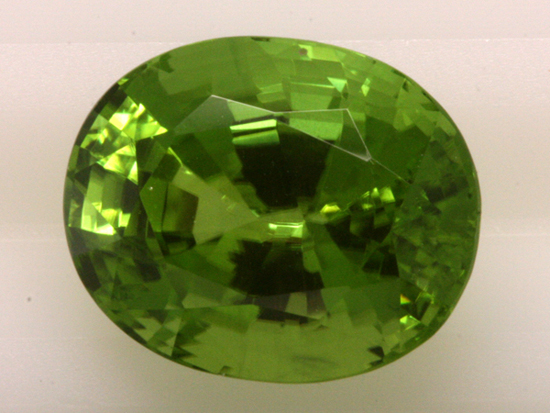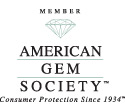Peridot- the “I don’t like my birthstone” Birthstone, Part 1
August 6th, 2009 by James L. Sweaney, CGA, FGA. GG
7.56 ct. Burma Peridot
We often hear statements like “I don’t like my birthstone” from folks born in August. In most cases, these people have never seen a really good peridot, so we make it our mission to show them gorgeous gems like this magnificent Burmese Peridot.
Peridot, pronounced pear-eh-doe, is a magnesium iron silicate mineral that is found numerous locations around the world, including Burma, Sri Lanka, China, and Pakistan. In the United States, Hawaii, North Carolina, and Arizona are sources for peridot–the San Carlos reservation in Arizona is currently a major commercial producer of good to better material. The famous Green Sand Beach of Hawaii is colored by myriad grains of peridot.
Another name for peridot is olivine, referring to the slightly brownish olive green color of many peridot crystals. The color of the best peridot ranges in tones of light to medium greenish yellow to warm green, with no brownish overtones. The color of peridot shows best in incandescent light–the green is rich and inviting and yellowish tones are less apparent–so it has the nickname “Evening Emerald.”
Peridot may have typical inclusions that resemble “lily pads,” but it is a gem that is frequently very pure and transparent. It takes a good polish and has a fairly high refractive index, so well cut peridots capture light very effectively. Since its color is not dark, peridot is known for its very bright eye catching sparkle.
Another characteristic of peridot is that it is never treated for color or clarity–it’s a gem that is totally natural.
Interestingly, peridot is the only gem that has been found in meteorites.
We often see peridot in estate jewelry-it’s bright color, reasonable price, and ready availability have made it a jeweler’s favorite for centuries.
Peridot forms well shaped crystals of good size, so large gems are not rare in the market place. Prices for peridot are relatively modest– ring sized stones, from 1 to 5 carats, retail for as little as $10 per carat for the lower quality commercial grades. The very best bright apple green stones may bring as much as $350 per carat up to 5 carats.
Larger stones in the 5 to 10 carat class that are suitable for beautiful jewelry can be purchased for $100 to $400 per carat. Premium museum quality large gems may top out at $700 per carat or more.
Peridot, a gem of good size and great beauty at reasonable cost, is one of the true treasures of the gem world. We’ll follow up with more blogs about folks who didn’t like their birthstone before they came to Mardon!
Tags: August, birthstone, Burma, green, Hawaii, mined in the US, peridot, San Carlos peridot







